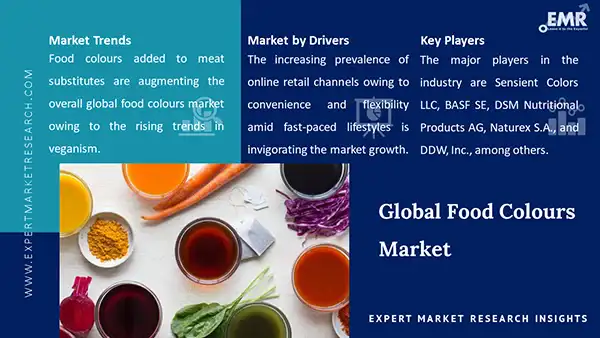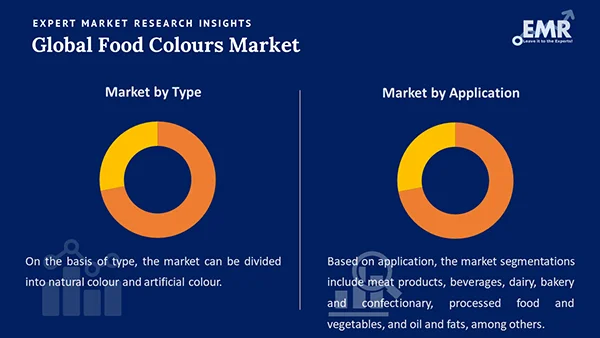
Consumer Insights
Uncover trends and behaviors shaping consumer choices today
Procurement Insights
Optimize your sourcing strategy with key market data
Industry Stats
Stay ahead with the latest trends and market analysis.
The global food colours market attained a value of about USD 3.66 Billion in 2025. The market is further expected to grow at a CAGR of 12.30% during the forecast period of 2026-2035 to reach approximately USD 11.68 Billion by 2035.
Base Year
Historical Period
Forecast Period
Compound Annual Growth Rate
12.3%
Value in USD Billion
2026-2035
*this image is indicative*
The global market for food colours is being driven by the rising demand for clean label, natural products globally. Due to the prevailing health concerns amidst the global pandemic, the industry is driven by factors, such as healthy food consumption and natural food colours like turmeric that adds to the health benefits, which are propelling the market growth. In addition, because of urbanisation and industrialisation, the rising purchasing power of people, and rising awareness regarding food adulteration and the resultant demand for clean label food products, the market demand for organic, plant-based products are augmenting the market.

Read more about this report - REQUEST FREE SAMPLE COPY IN PDF
Additionally, as natural colours are free of chemical adulteration, they possess no threat to the human body, hence making them favourable for everyday consumption. Furthermore, demand for natural colours in ready-to-drink and ready-to-go beverages, owing to the fast-paced lifestyles and dual-income households, is further invigorating the industry growth. Moreover, demand for packed and processed food products are creating a robust demand for food colours that not only enhance the appearance of the food product and grab customers attention but are also healthy in consumption. This is propelling the market growth of food colours.

Read more about this report - REQUEST FREE SAMPLE COPY IN PDF
Food colours are additives that enhance the appearance of the food product, making it more desirable for consumption. The colours may be available in liquid or powdered form as dyes and pigments that may be natural or artificial in their composition.
Market Breakup by Type
Market Breakup by Application
Market Breakup by Region
The market for food colours is being driven by the rise in the prevalence of e-commerce websites due to factors such as a rise in the number of working populations, convenience and flexibility of online shopping, fast deliveries, and stringent government regulations to practice social distancing amidst the global pandemic. With the ease in availability of the internet and the rising penetration of smartphones, online delivery channels are sustaining the market for food colours in various end-use industries.
Furthermore, owing to the thriving e-commerce industry, industry players who deal in packed and processed food products over online retail channels are generating market demand for vibrant colours that attract customers as the visual appearance of online products is critical. Furthermore, due to the emergence of food delivery platforms like Zomato and Uber Eats in major developed and developing countries, the importance of vivid colours in visual representation is further contributing to the overall market of food colours.
The report presents a detailed analysis of the following key players in the global food colours market, looking into their capacity, market share, and latest developments like capacity expansions, plant turnabouts and mergers and acquisitions.
The comprehensive report looks at the micro and macro aspects of the industry. The EMR report gives an in-depth insight into the market by providing a SWOT analysis as well as an analysis of the Porter’s Five Forces Model.




*While we strive to always give you current and accurate information, the numbers depicted on the website are indicative and may differ from the actual numbers in the main report. At Expert Market Research, we aim to bring you the latest insights and trends in the market. Using our analyses and forecasts, stakeholders can understand the market dynamics, navigate challenges, and capitalize on opportunities to make data-driven strategic decisions.*
Get in touch with us for a customized solution tailored to your unique requirements and save upto 35%!
The global food colours market attained a value of nearly USD 3.66 Billion in 2025.
The market is projected to grow at a CAGR of 12.30% in the forecast period of 2026-2035.
The market is estimated to witness healthy growth in the forecast period of 2026-2035 to reach about USD 11.68 Billion by 2035.
The market is being driven by the surging demand for natural colours and the rising awareness regarding healthy food consumption and clean label products.
The key trends of the market include the growing prevalence of e-commerce websites and online food delivery channels and the rising demand for vibrant food colours.
The major regional markets for food colours are North America, Latin America, the Asia Pacific, Europe, and the Middle East and Africa.
The significant types of food colours are natural colour and artificial colour.
The leading applications of food colours include meat products, beverages, dairy, bakery and confectionary, processed food and vegetables, and oil and fats, among others.
The key players in the global food colours market are Sensient Colors LLC, Chr. Hansen Natural Colors A/S, BASF SE, DSM Nutritional Products AG, Naturex S.A., and DDW, Inc., among others.
Explore our key highlights of the report and gain a concise overview of key findings, trends, and actionable insights that will empower your strategic decisions.
| REPORT FEATURES | DETAILS |
| Base Year | 2025 |
| Historical Period | 2019-2025 |
| Forecast Period | 2026-2035 |
| Scope of the Report |
Historical and Forecast Trends, Industry Drivers and Constraints, Historical and Forecast Market Analysis by Segment:
|
| Breakup by Type |
|
| Breakup by Application |
|
| Breakup by Region |
|
| Market Dynamics |
|
| Competitive Landscape |
|
| Companies Covered |
|
| Report Price and Purchase Option | Explore our purchase options that are best suited to your resources and industry needs. |
| Delivery Format | Delivered as an attached PDF and Excel through email, with an option of receiving an editable PPT, according to the purchase option. |
Single User License
One User
USD 3,999
USD 3,599
tax inclusive*
Datasheet
One User
USD 2,499
USD 2,249
tax inclusive*
Five User License
Five User
USD 4,999
USD 4,249
tax inclusive*
Corporate License
Unlimited Users
USD 5,999
USD 5,099
tax inclusive*
*Please note that the prices mentioned below are starting prices for each bundle type. Kindly contact our team for further details.*
Flash Bundle
Small Business Bundle
Growth Bundle
Enterprise Bundle
*Please note that the prices mentioned below are starting prices for each bundle type. Kindly contact our team for further details.*
Flash Bundle
Number of Reports: 3
20%
tax inclusive*
Small Business Bundle
Number of Reports: 5
25%
tax inclusive*
Growth Bundle
Number of Reports: 8
30%
tax inclusive*
Enterprise Bundle
Number of Reports: 10
35%
tax inclusive*
How To Order

Select License Type
Choose the right license for your needs and access rights.

Click on ‘Buy Now’
Add the report to your cart with one click and proceed to register.

Select Mode of Payment
Choose a payment option for a secure checkout. You will be redirected accordingly.
Gain insights to stay ahead and seize opportunities.

Get insights & trends for a competitive edge.

Track prices with detailed trend reports.

Analyse trade data for supply chain insights.

Leverage cost reports for smart savings

Enhance supply chain with partnerships.

Connect For More Information
Our expert team of analysts will offer full support and resolve any queries regarding the report, before and after the purchase.
Our expert team of analysts will offer full support and resolve any queries regarding the report, before and after the purchase.
We employ meticulous research methods, blending advanced analytics and expert insights to deliver accurate, actionable industry intelligence, staying ahead of competitors.
Our skilled analysts offer unparalleled competitive advantage with detailed insights on current and emerging markets, ensuring your strategic edge.
We offer an in-depth yet simplified presentation of industry insights and analysis to meet your specific requirements effectively.
Share